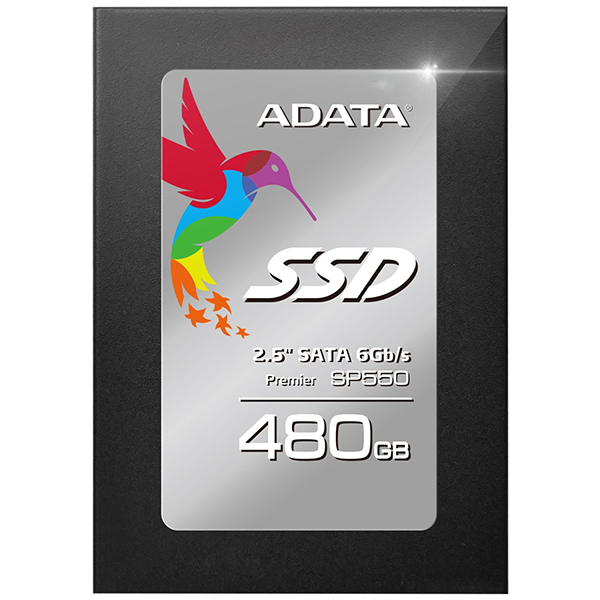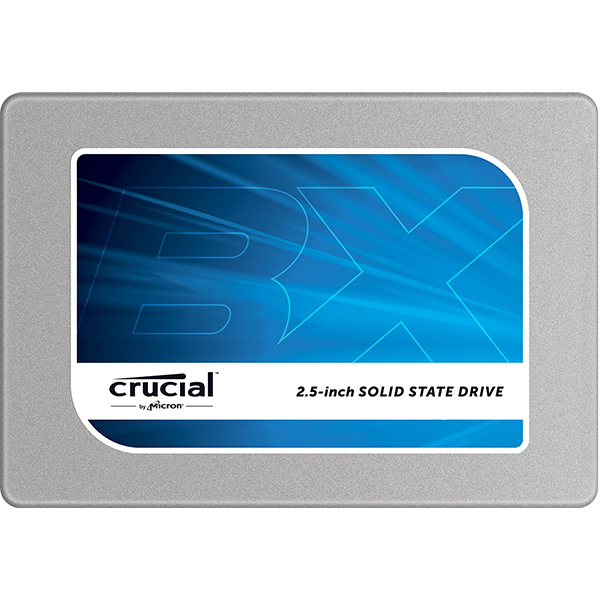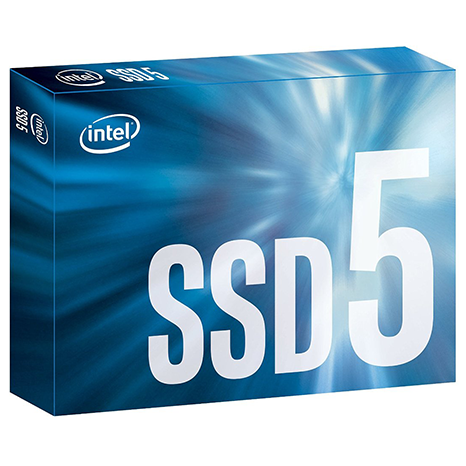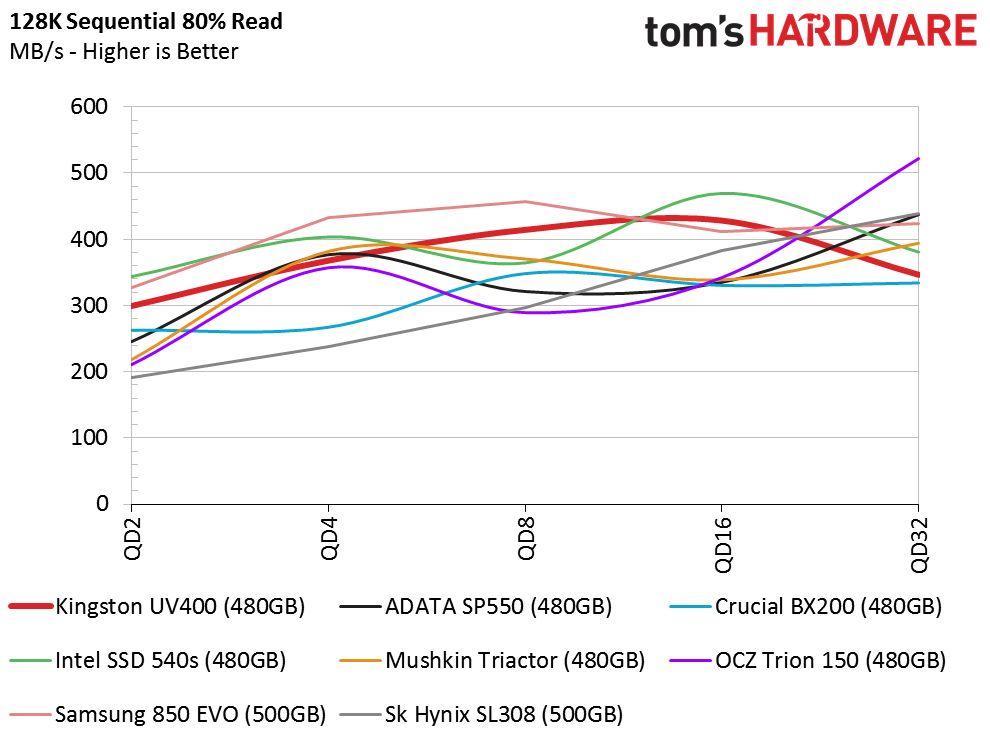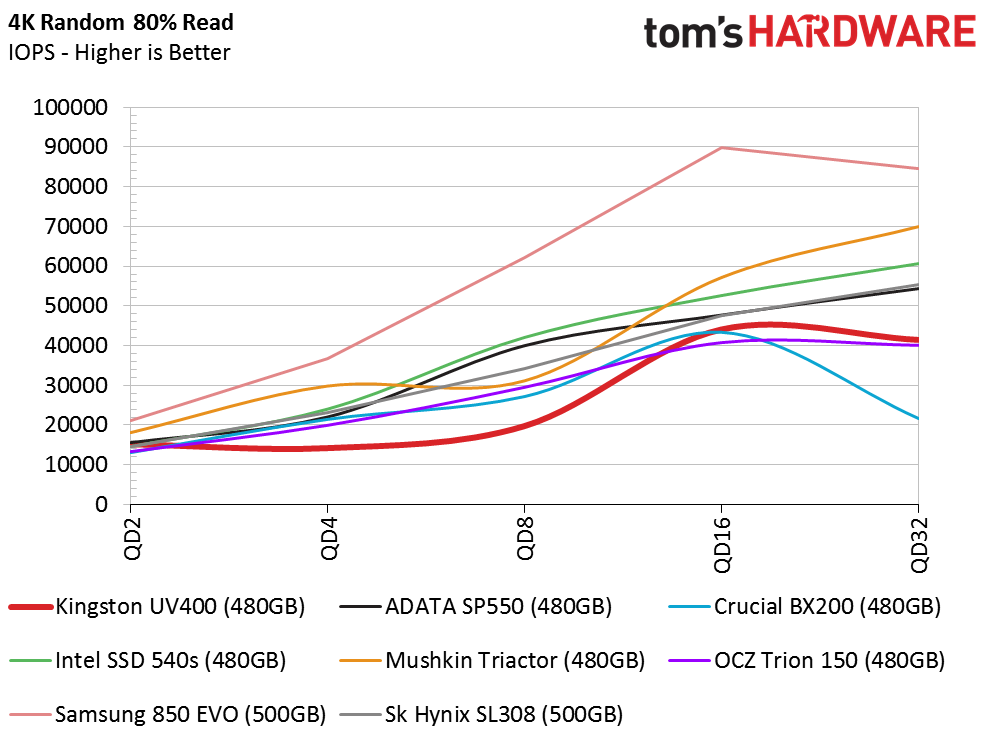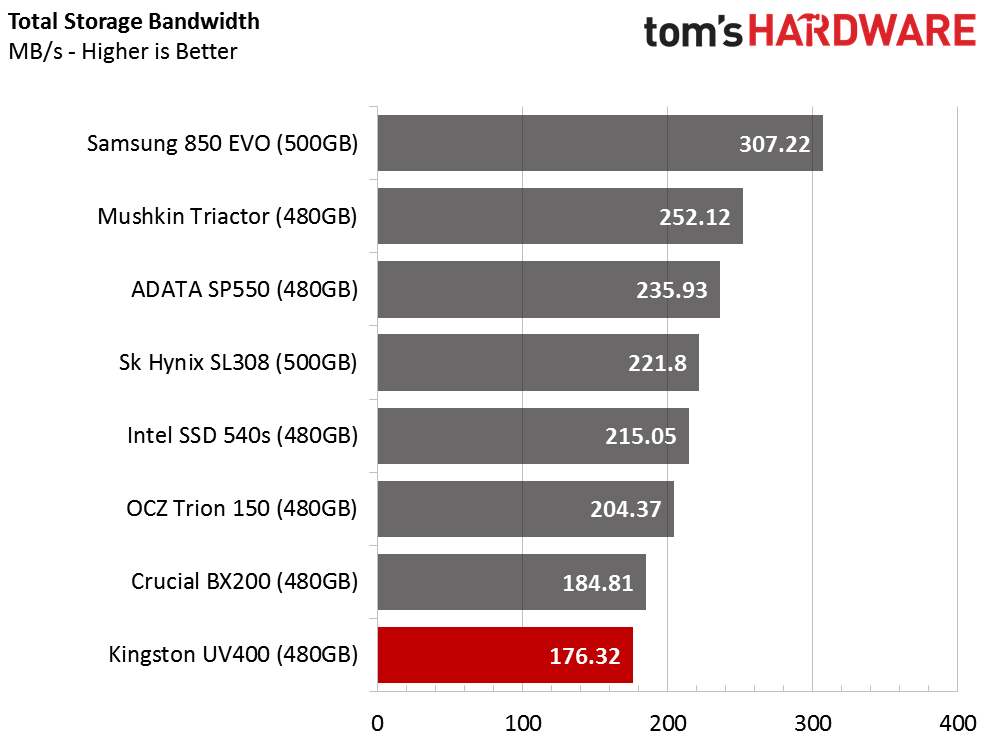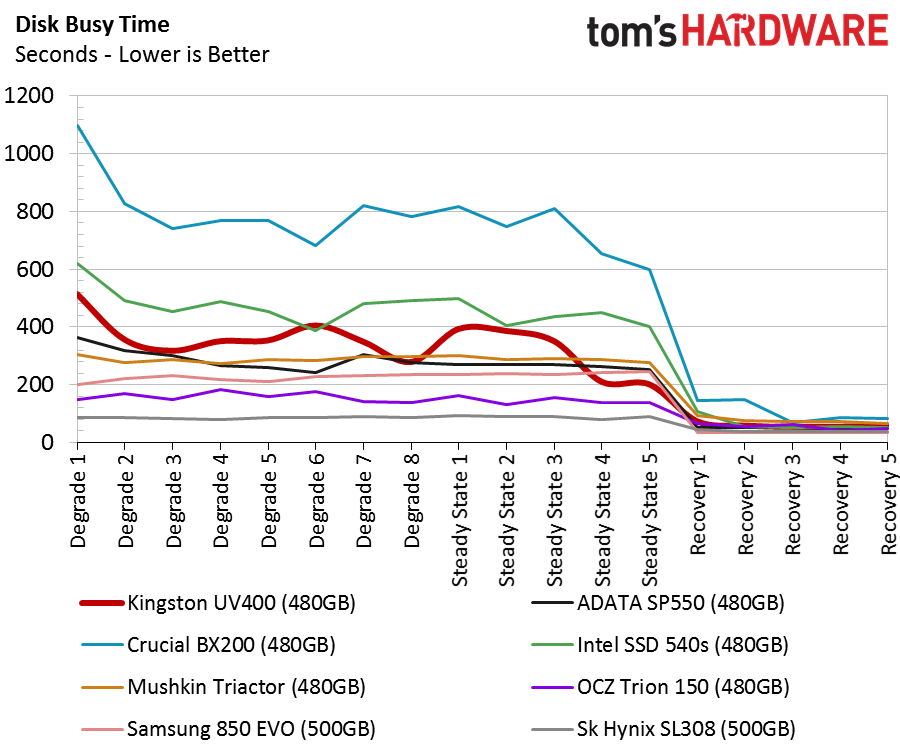Kingston SSDNow UV400 480GB SSD Review
As the name suggests, Kingston's UV series brings the ultra value. The new UV400 should be a very popular product for value-focused shoppers because Kingston designed it to provide high capacity flash-based storage on a beggar's budget.
Why you can trust Tom's Hardware
Comparisons & Benchmarks
Comparison Products
All of the products used for this review utilize three-bit per cell flash (TLC) and fall into the entry-level and mainstream consumer SSD segment. For the last few years, the Samsung 850 EVO dominated this market segment with a mainstream price but enthusiast-level performance. The 850 EVO's price has bounced around over the last couple of months. Samsung now offers the 750 EVO with planar NAND to service the entry-level market and, as expected, the 850 EVO's price has slowly crept up in some capacities. The price increase has opened the door for other products to fill the entry-level space.
The new Sk Hynix SL308 is one of the 850 EVO 500GB's closest competitors, but new products from Mushkin and Intel are not far behind, either.
Sequential Read Performance
To read about our storage tests in-depth, please check out How We Test HDDs And SSDs. Four-corner testing is covered on page six of our How We Test guide.
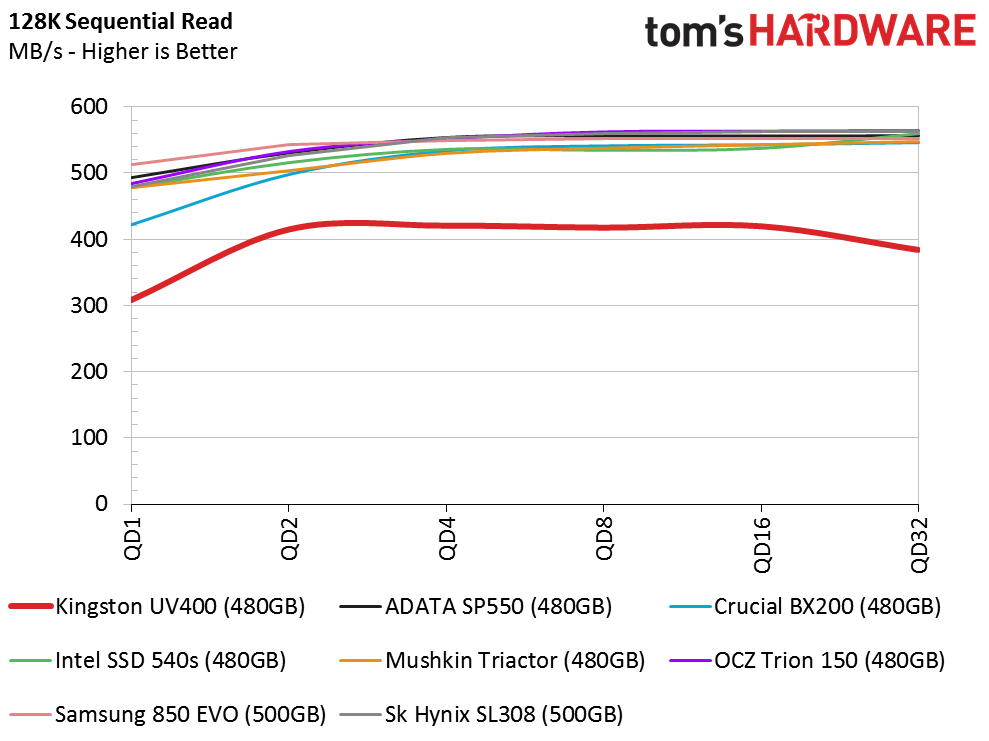
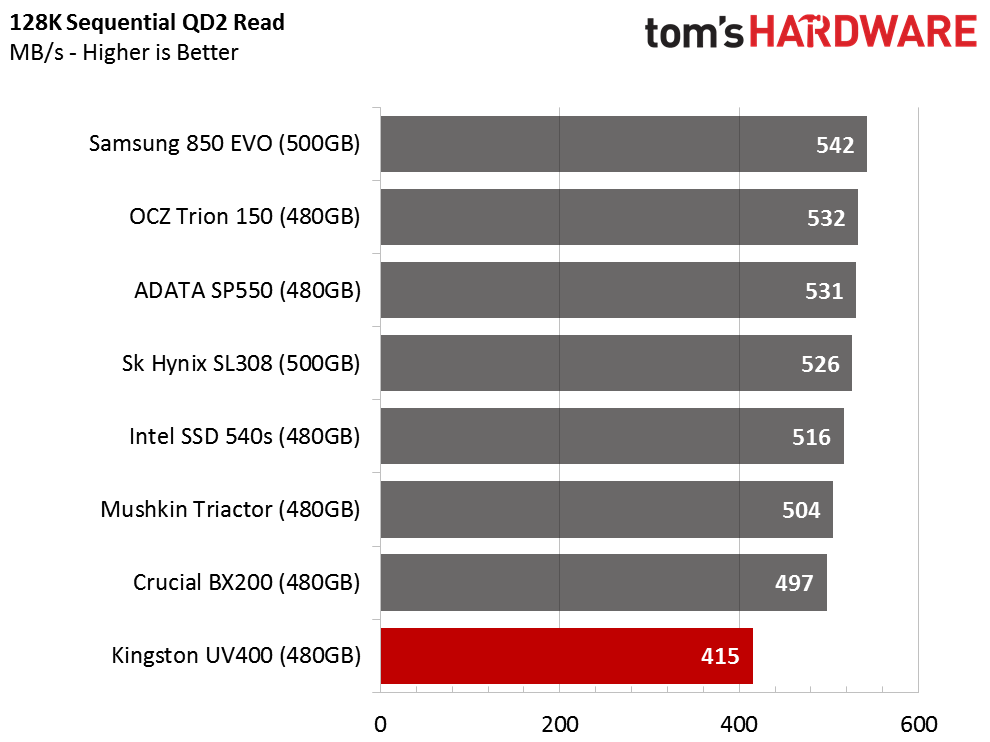
The UV400 480GB will not win any awards on performance alone, it is a pure value product for an often-neglected corner of the market. Kingston rated the UV400 SSD at 550 MB/s sequential writes, and we reached that high mark but not with a 128KB block size. The UV400 needs larger blocks to reach peak performance, but other products in this category would also offer increased performance with larger blocks.
Sequential Write Performance
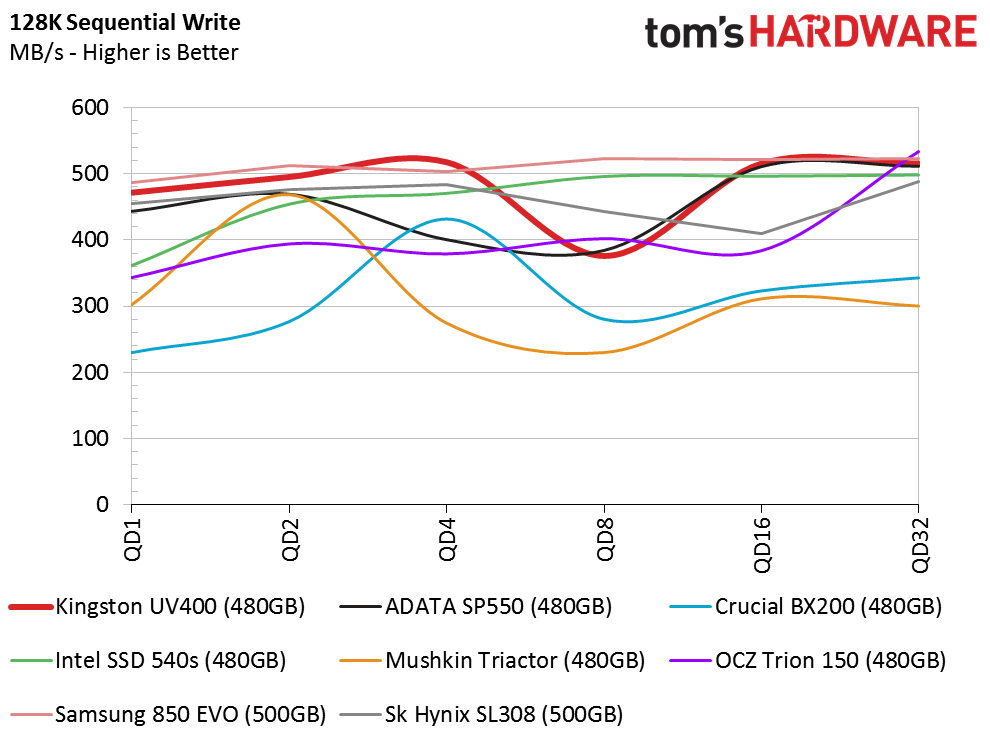
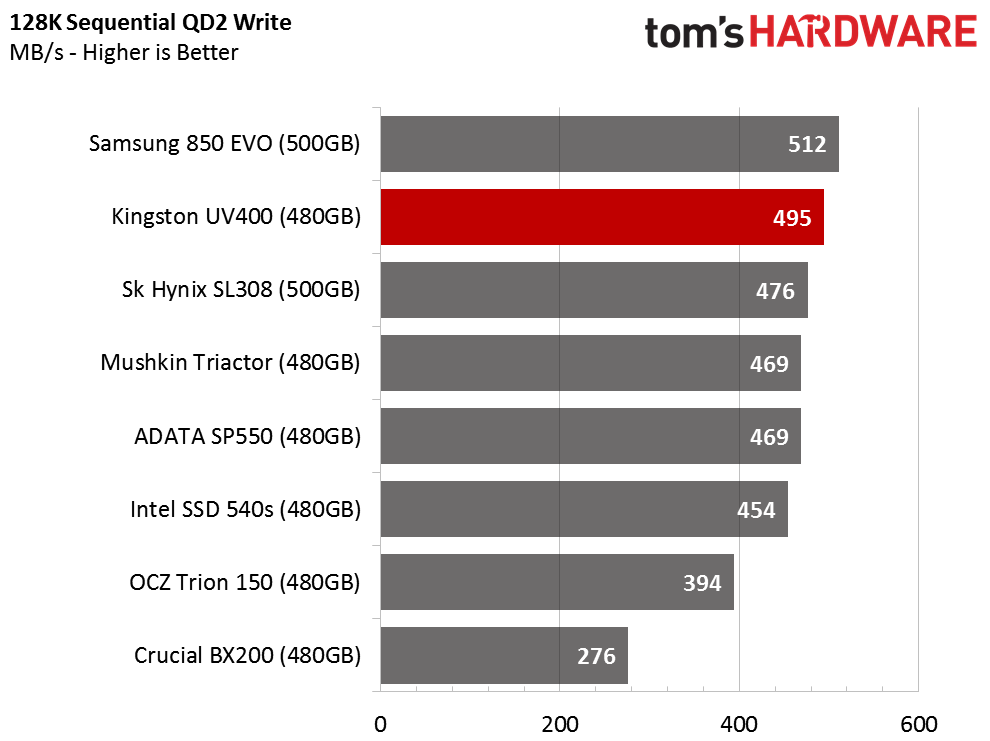
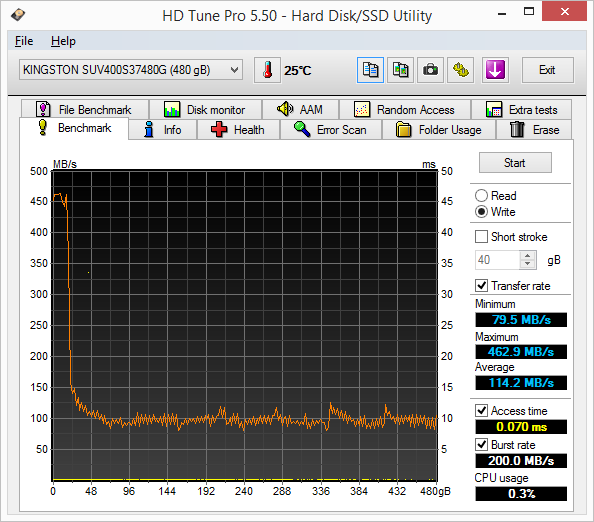
The UV400 480GB delivers better sequential write performance than the specifications lead us to believe. The UV400's SLC buffer is a little larger than most low-cost products shipping today. Some products offer larger dynamic SLC caches, but it shrinks as the drive fills.
We do worry about post-SLC cache performance. The sequential write speed with 128KB blocks drops down to just 100 MB/s when the cache is full. We saw this level of performance before most companies moved over to direct-to-die writes in low-cost TLC-based SSDs. The UV400 should be able to double its performance with a direct-to-die algorithm, but it comes at the expense of endurance. 100 MB/s is nearly as fast as your gigabit Ethernet connection, but the low-capacity UV400 products will have lower performance. For us, if a drive can accept gigabit Ethernet speeds we approve the product (or at least dislike it less). You will want a 480GB or larger model if you want to transfer data from your network to the system with the UV400.
Random Read Performance

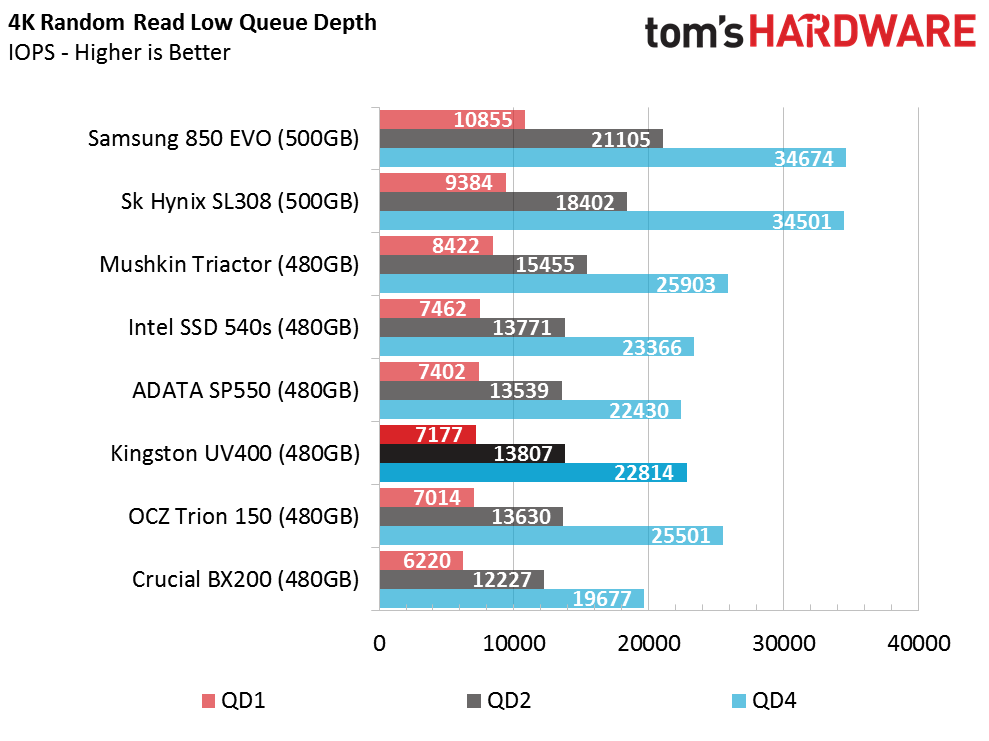
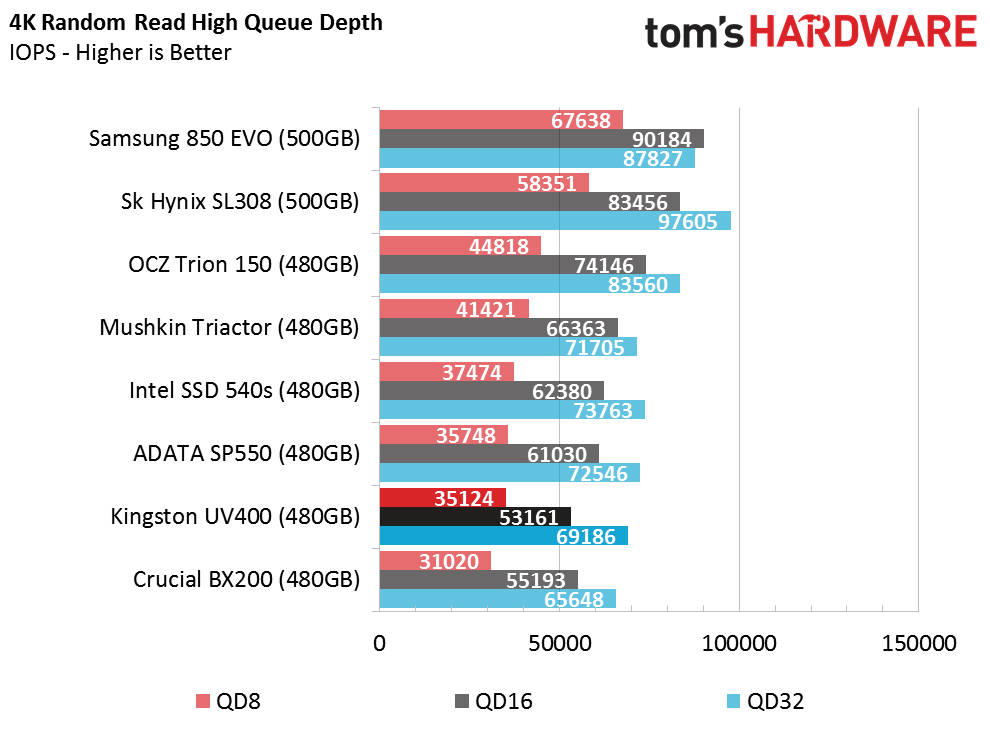
The UV400 has low random read performance for a modern SSD. This is an important test because it helps measure the user experience. The price told us right out of the gate that the UV400’s performance would be lower than many other SSDs. The price doesn't say how much faster the UV400 is than a hard disk drive, though. We recently tested the fastest consumer hard drive, and it delivers just over 200 sustained random read IOPS. Flash, in almost all of its forms, is still faster than any hard disk drive.
Get Tom's Hardware's best news and in-depth reviews, straight to your inbox.
Random Write Performance
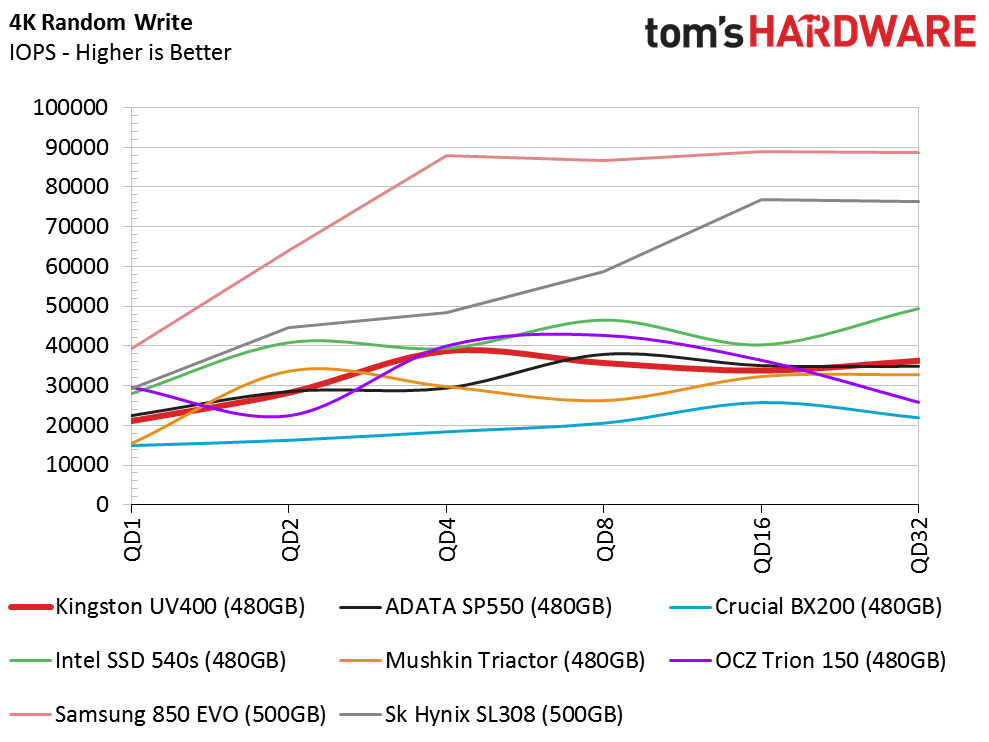
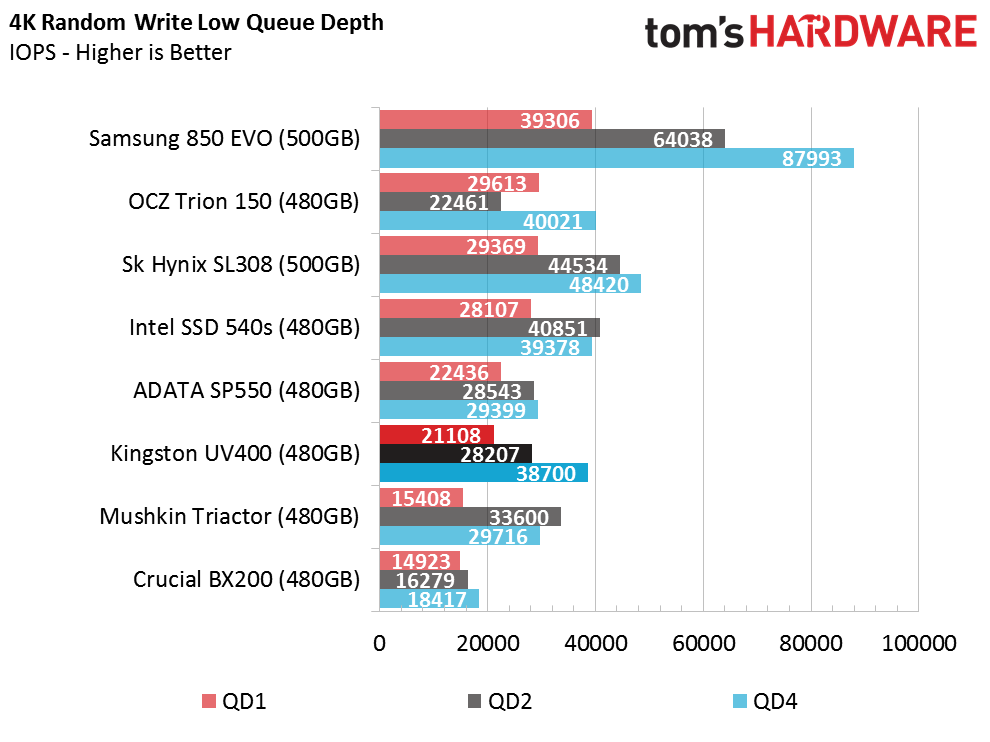
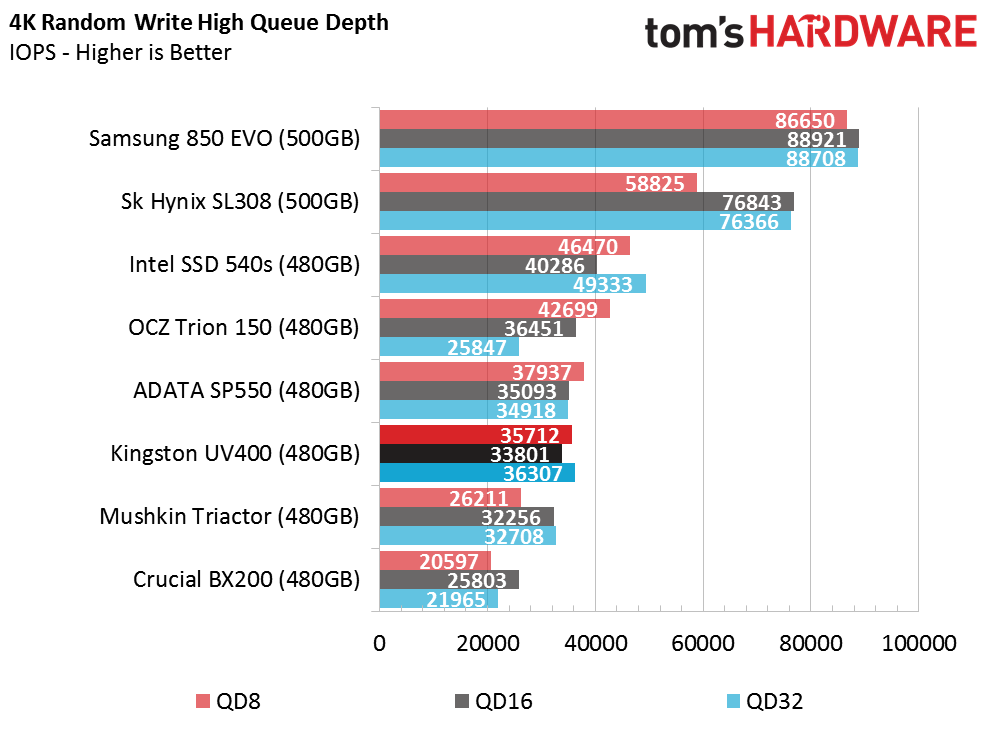
The UV400 also provides lower random write IOPS compared to mainstream SSDs like the Samsung 850 EVO 500GB. When we compare the UV400 to other entry-level SSDs with the same capacity, it falls into the middle of the pack and even outperforms the popular Crucial BX200.
80 Percent Sequential Mixed Workload
We describe our mixed workload testing in detail here, and describe our steady state tests here.
The Marvell 88SS1074 "Dean" controller does a really good job with mixed sequential data outside of steady-state. We've tested a handful of drives with this controller, and they all seem to perform well during this workload.
80 Percent Random Mixed Workload
We've also noticed the same controller perform poorly with mixed random workloads. We expected the low performance because the SSD has a limited number of channels to pass the data to the controller, which limits parallelism.
Sequential Steady-State
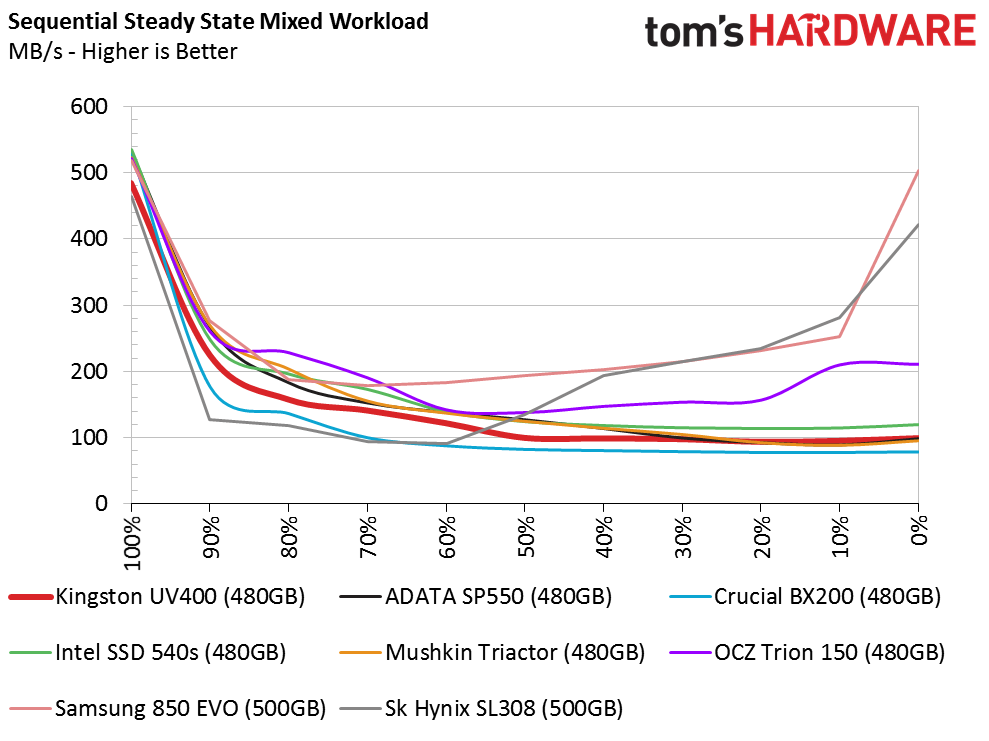
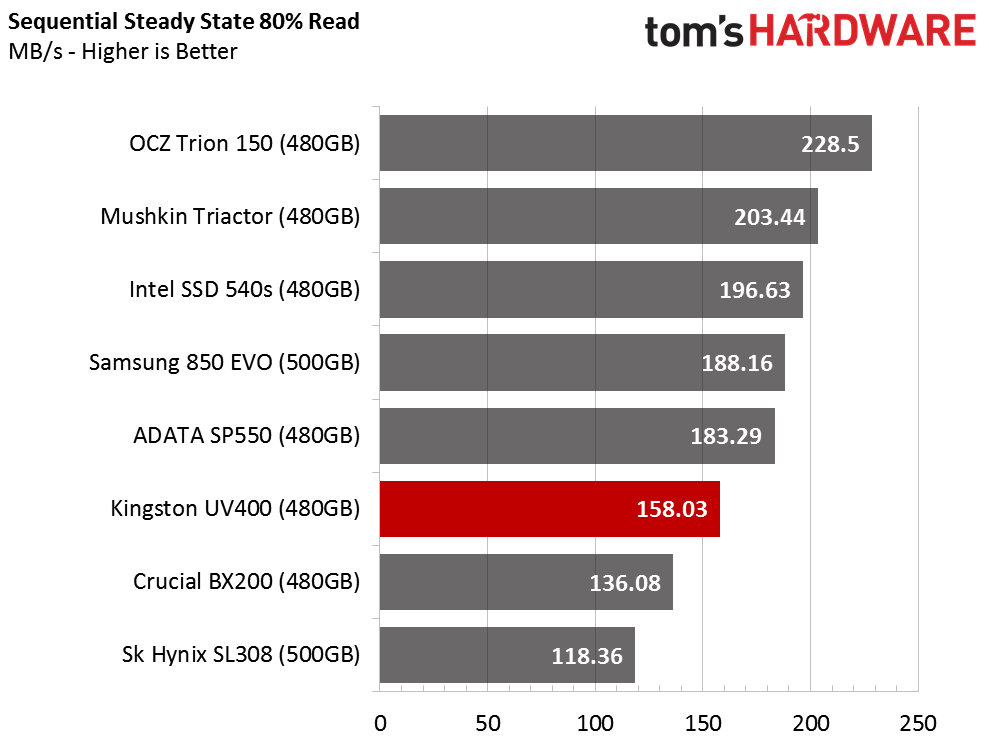
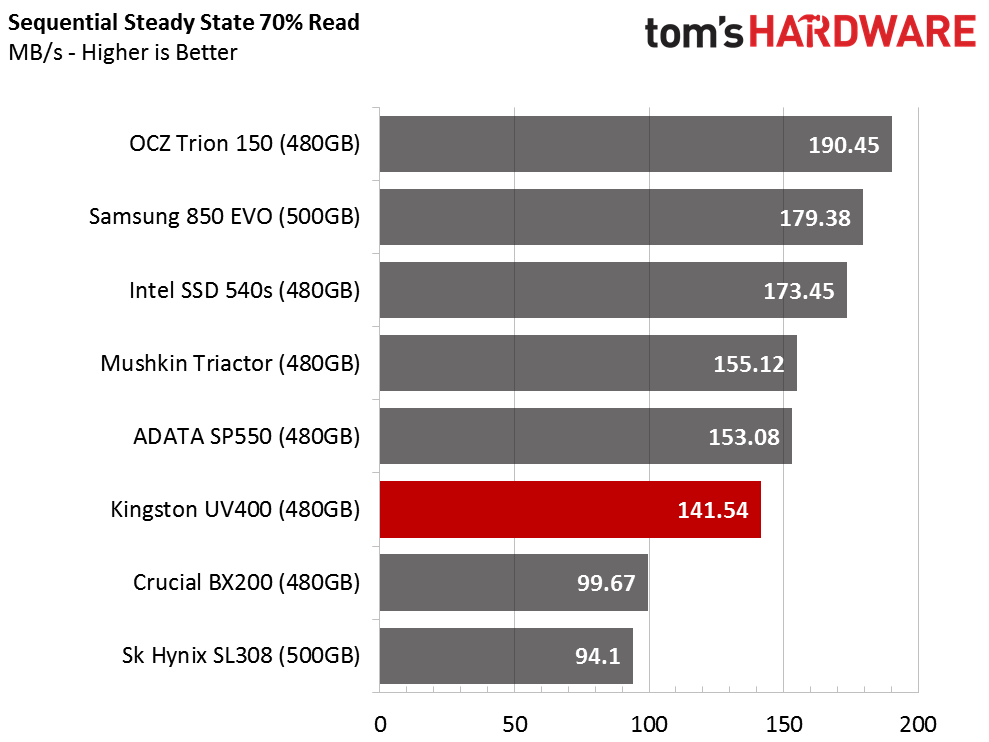
Kingston did not design the UV400 for steady-state workloads, and the chart shows why. It takes a large amount of data writes to get an SSD into a steady state. After a heavy write workload, the dirty cells add latency to outstanding commands due to the read, modify, and write cycle. This product reserves some space for background activity, but if you want to keep the performance high, you would want to partition the 480GB as 400GB. This technique leaves some extra room for background activities.
Random Steady-State
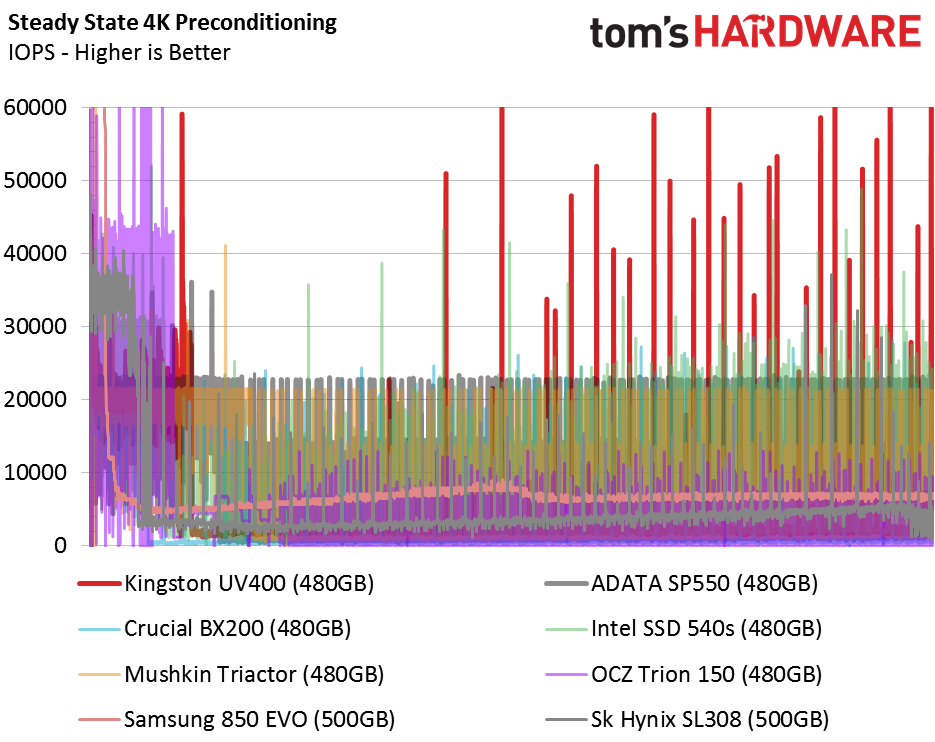
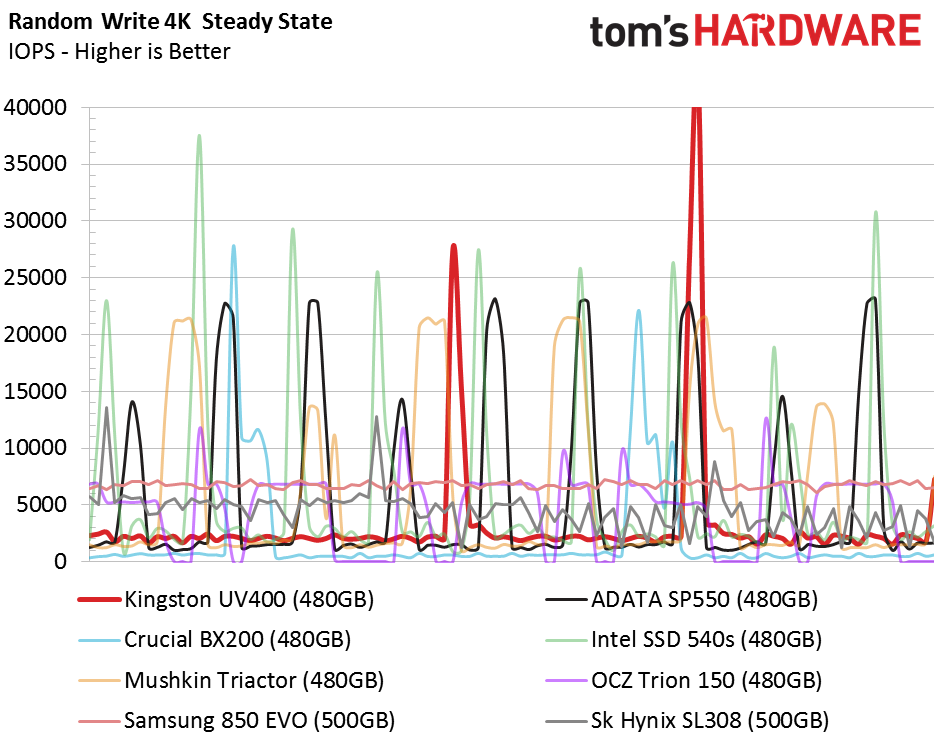
We use the random steady state test to measure performance consistency and to identify products that will potentially perform well in a RAID environment. The Kingston UV400 delivers a fairly steady write speed with very few peaks and valleys. The steady level just doesn't get very high off the ground so we wouldn't recommend this series for RAID.
PCMark 8 Real-World Software Performance
For details on our real-world software performance testing, please click here.
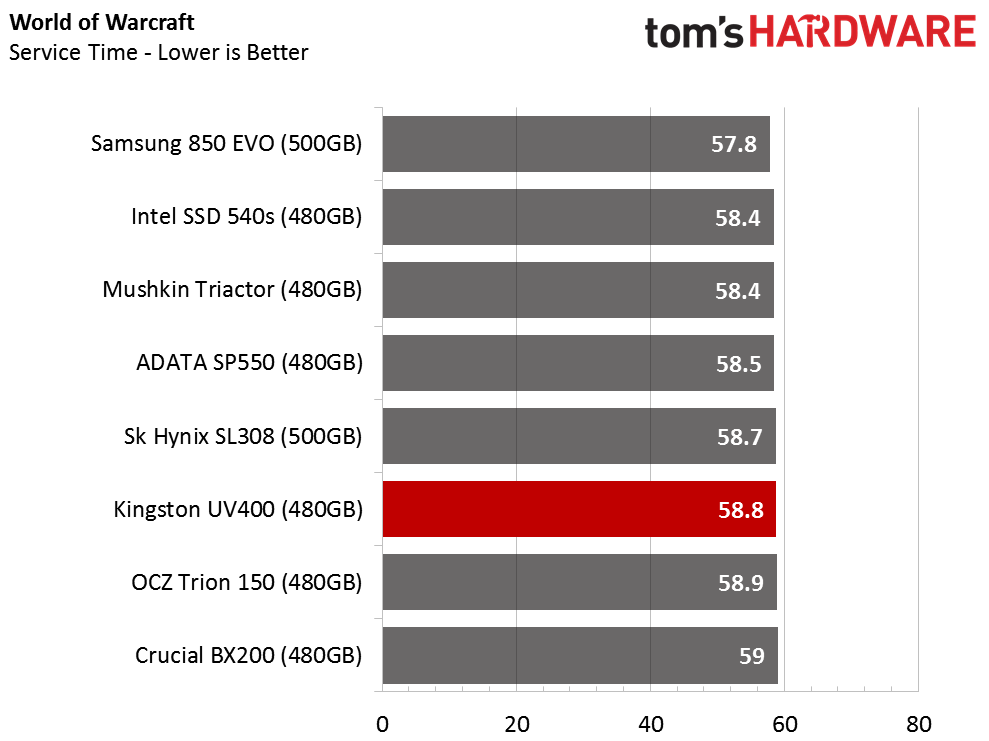
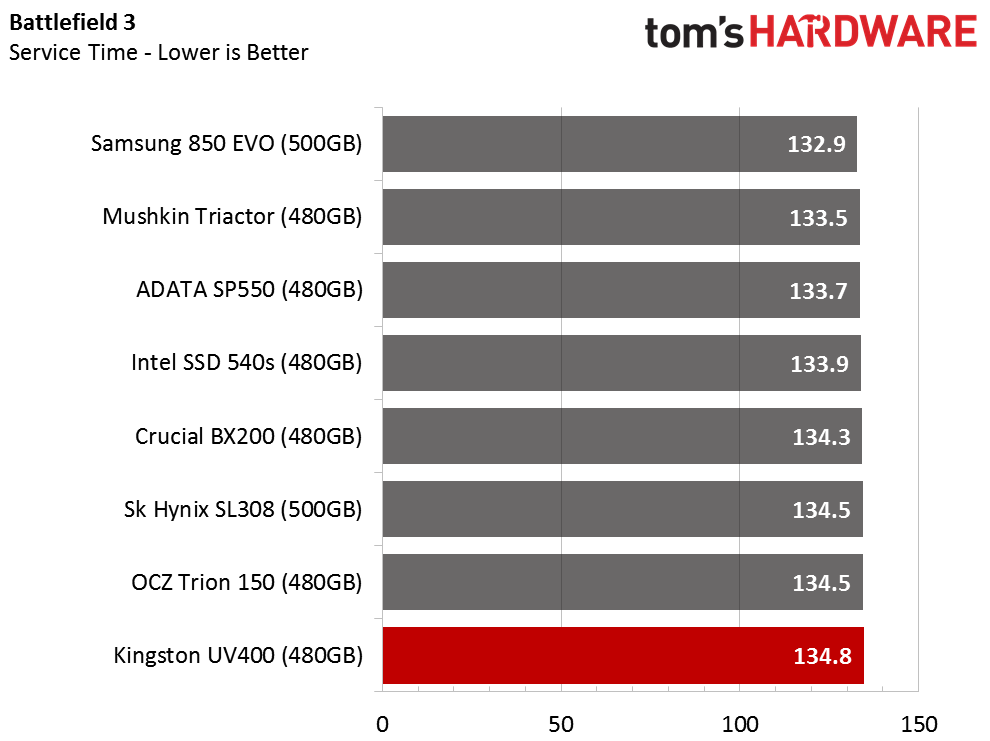
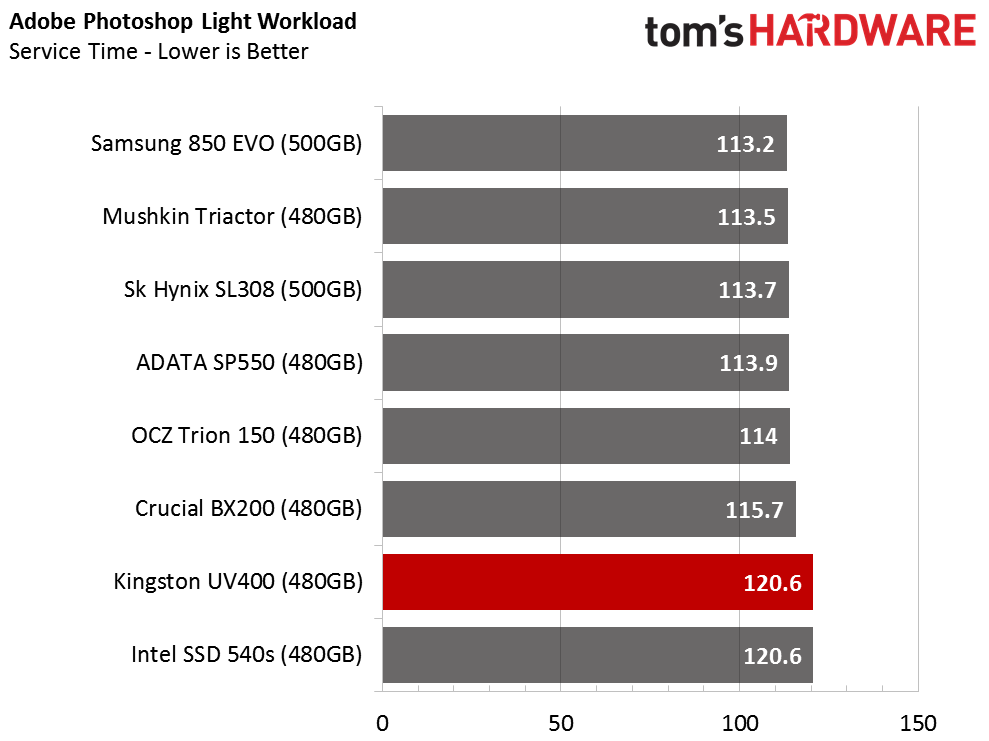
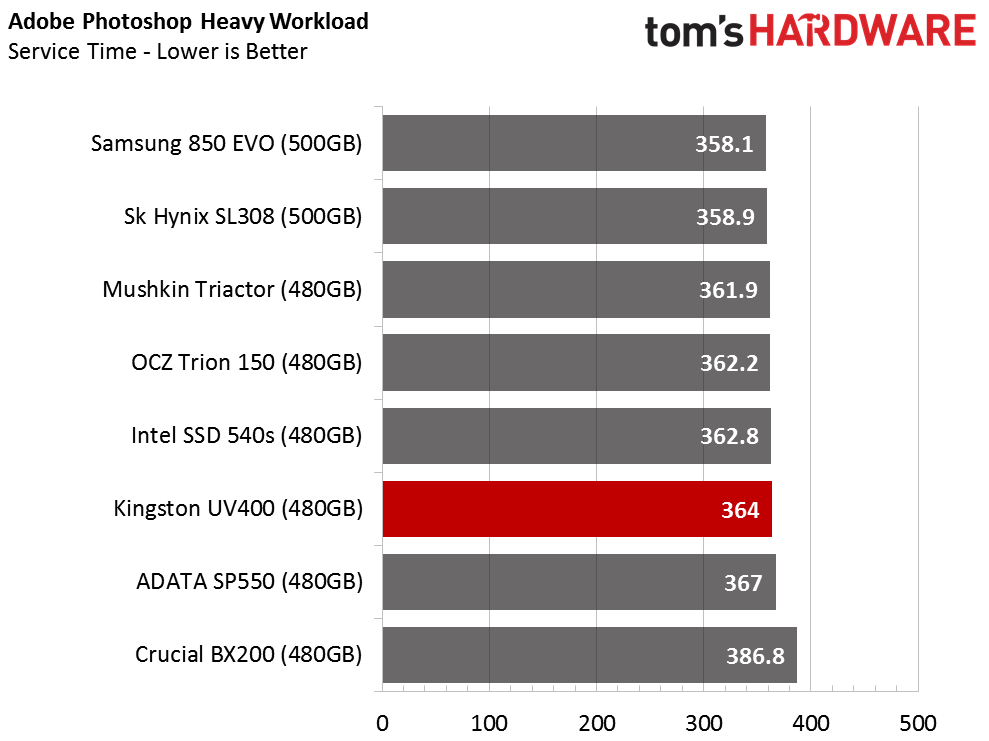
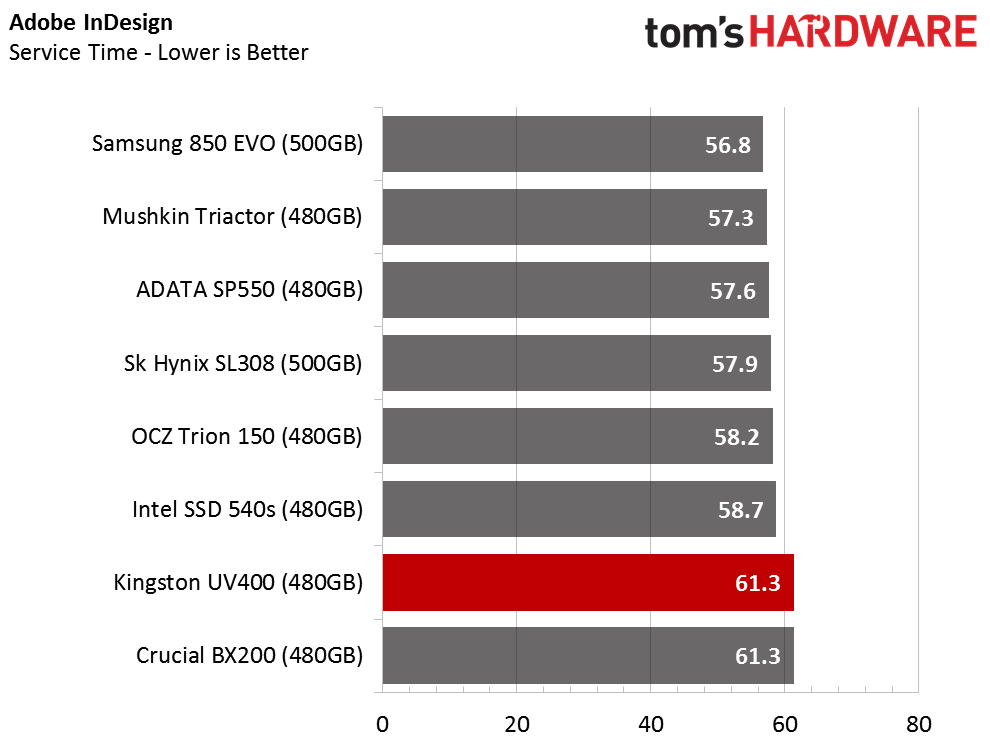
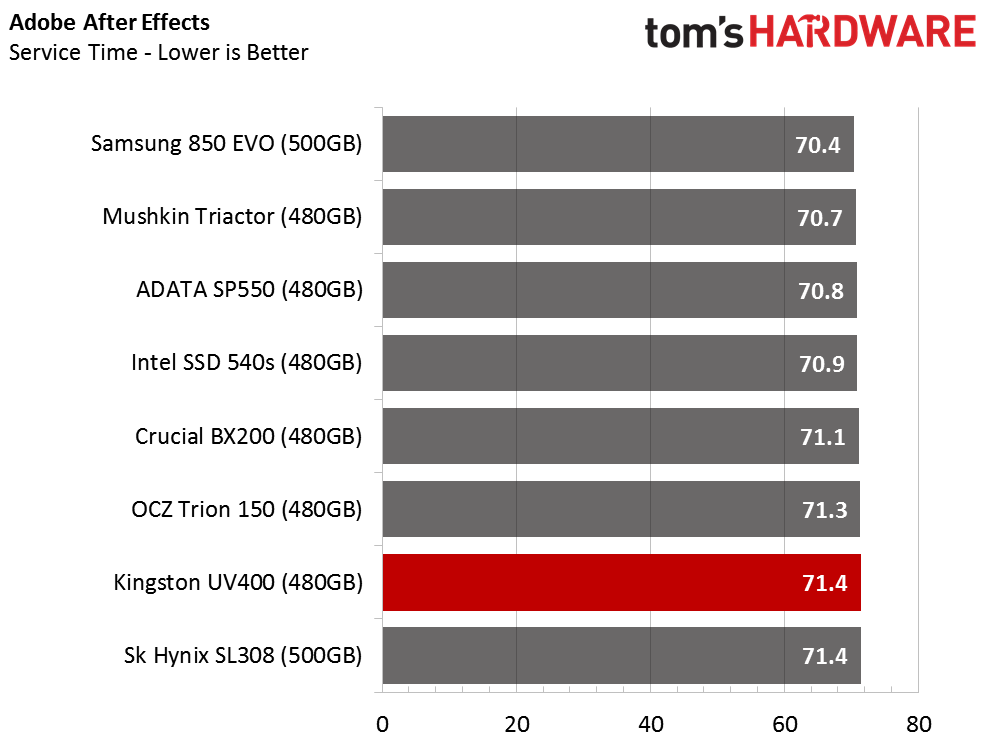
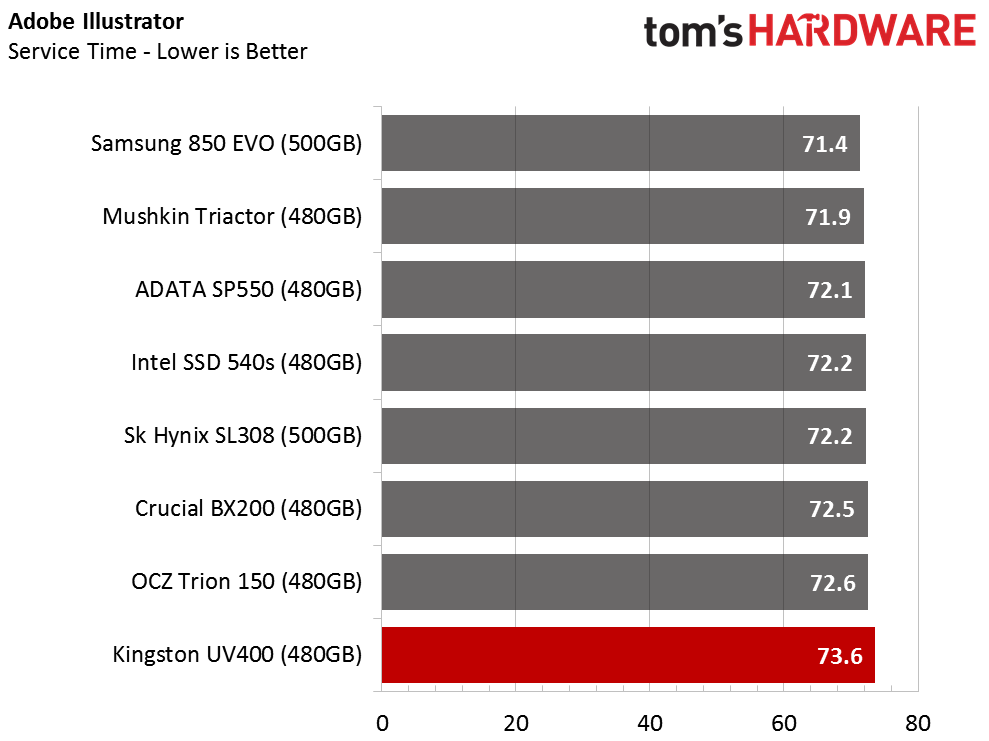
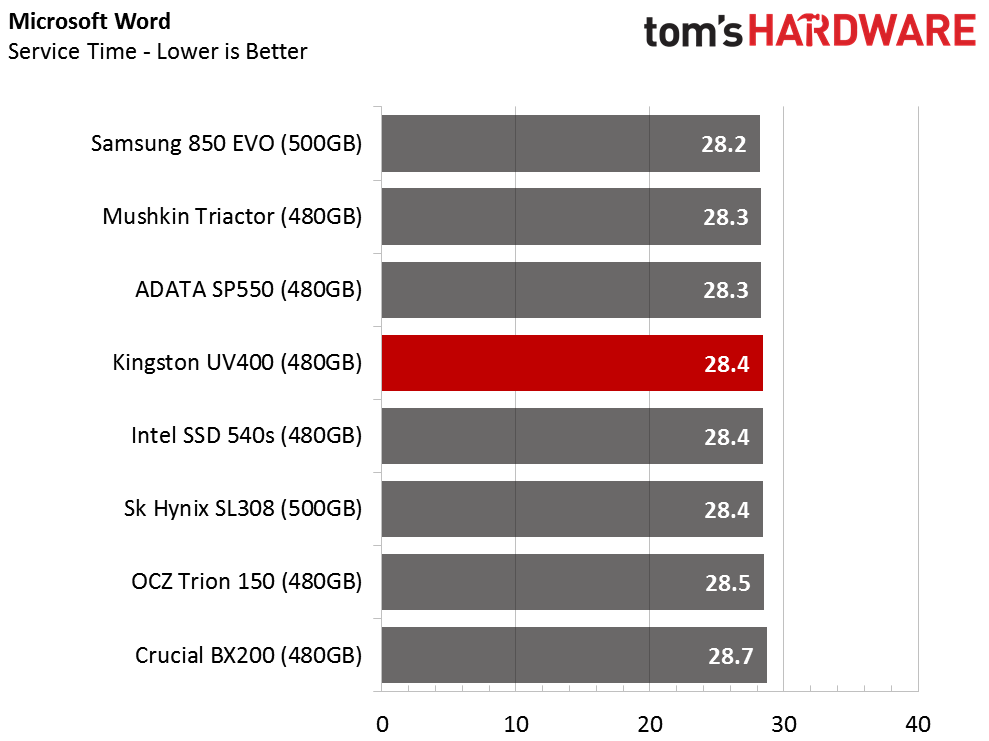
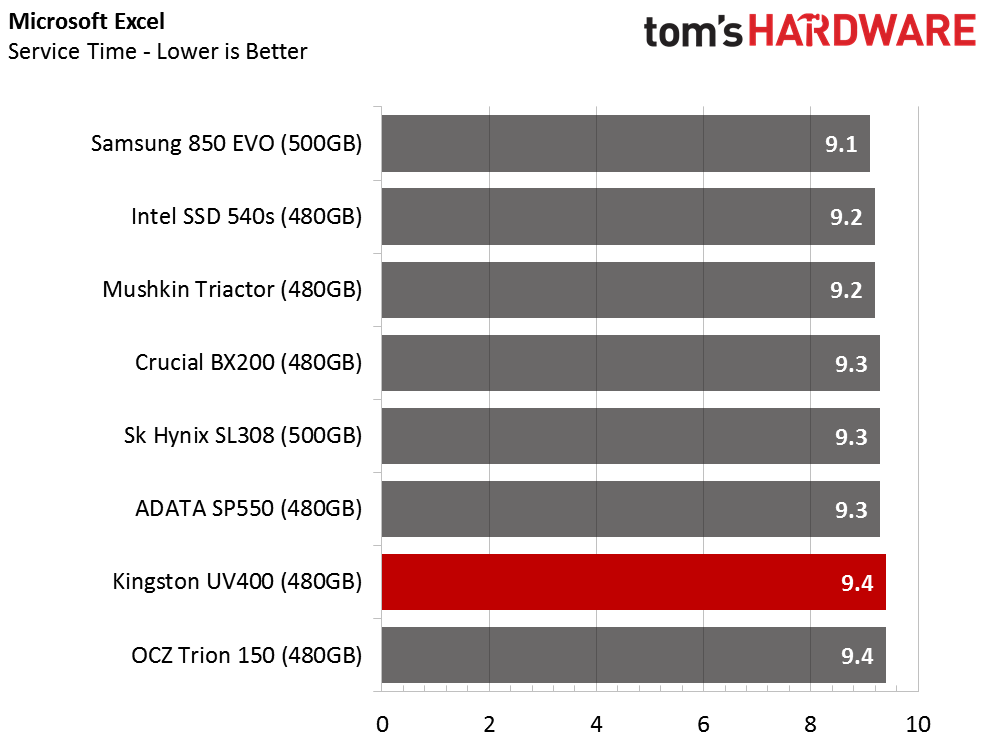
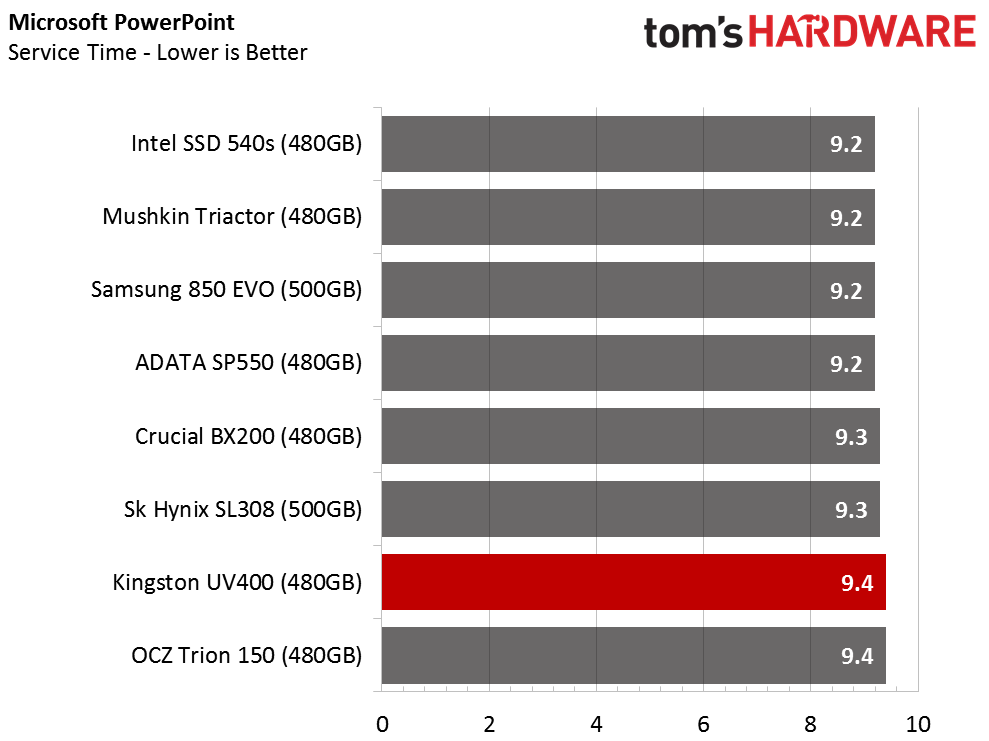
The Kingston doesn't take the most time to complete all of the tasks, but we found the drive at the bottom of the application test charts more often than not. All of the products on the charts are entry-level SSDs, except the mainstream Samsung 850 EVO 500GB. The UV400 is slower than most of the SSDs during a number of tasks.
Application Storage Bandwidth
The UV400 slides to the bottom of the chart when you combine the tests and average the results into a throughput score. The Samsung 850 EVO is nearly twice as fast, but I wouldn't say it delivers a 2x improvement in the user experience. For most people, we would recommend the other products over the UV400 if you found them for sale at the same price.
PCMark 8 Advanced Workload Performance
To learn how we test advanced workload performance, please click here.
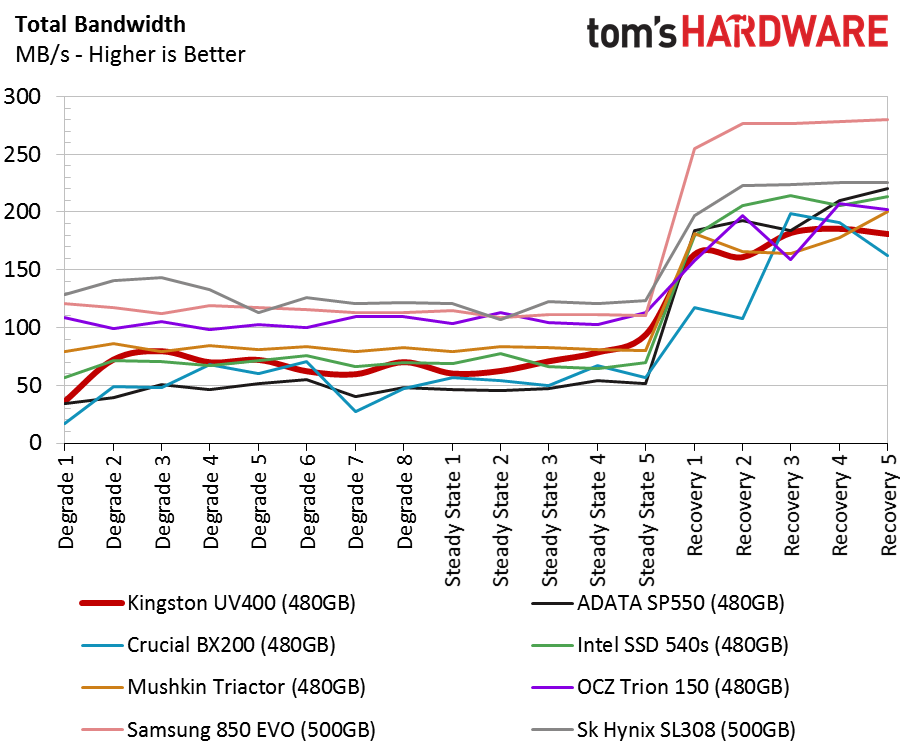
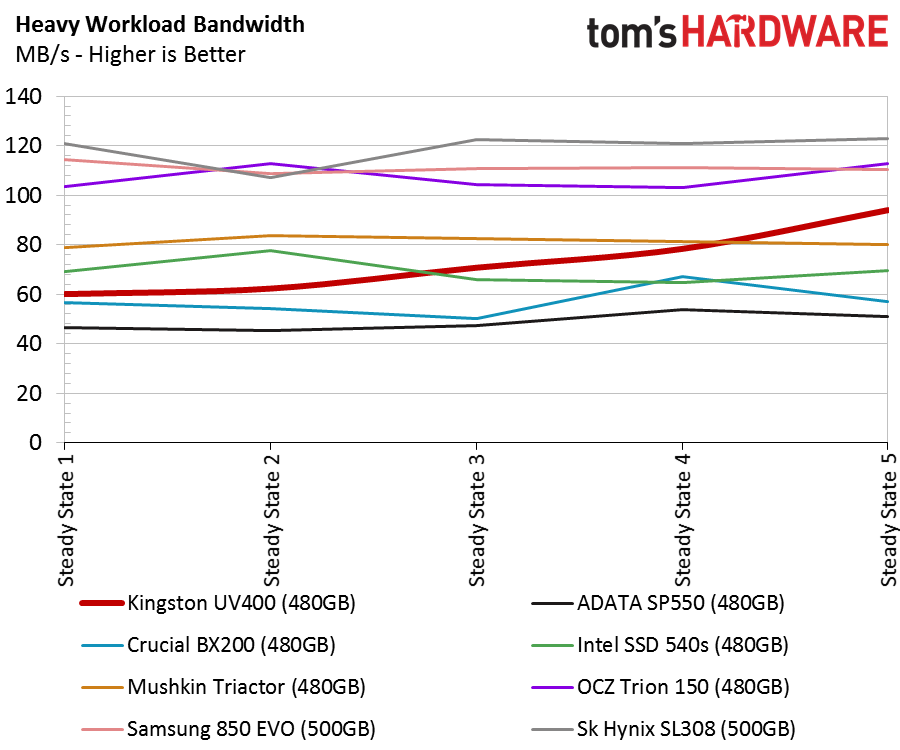
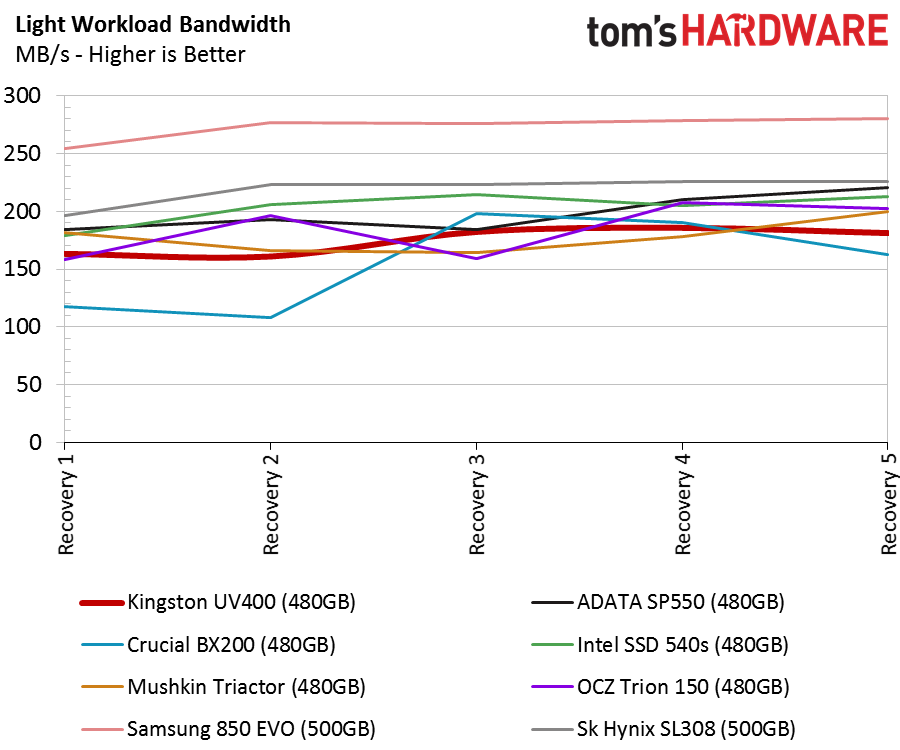
The low performance carries over to the demanding tests with data on the drive. Again, the Kingston UV400 trails many of the other entry-level products. The only portion of the test we focus on with entry-level solid-state drives is the recovery phase. The heavy-use tests measure workstation-level workloads, and you shouldn’t use many of these products in that type of environment.
Total Service Time
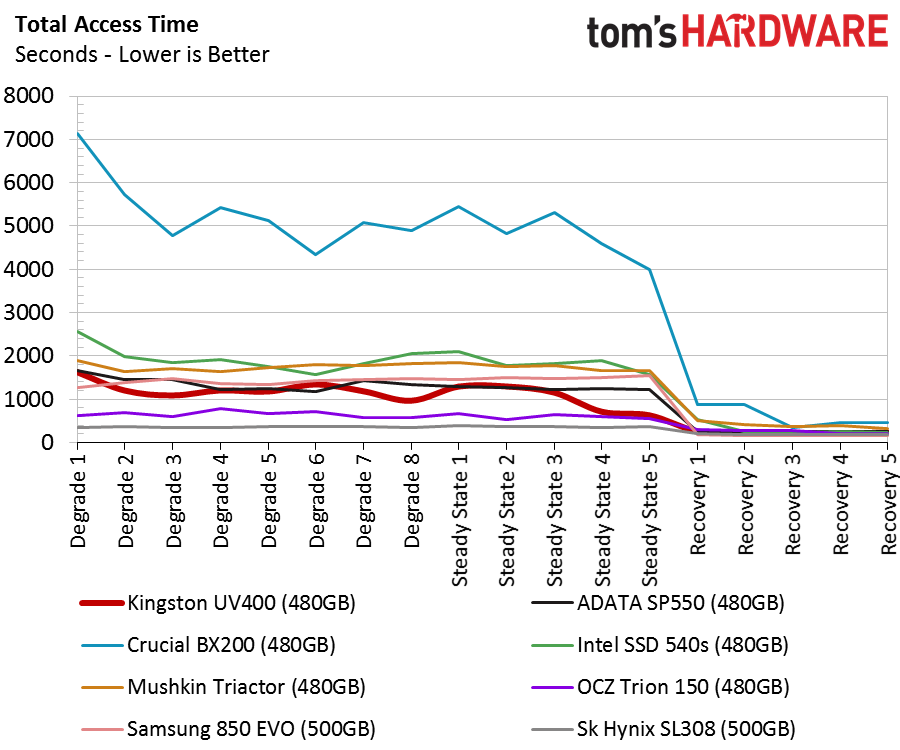
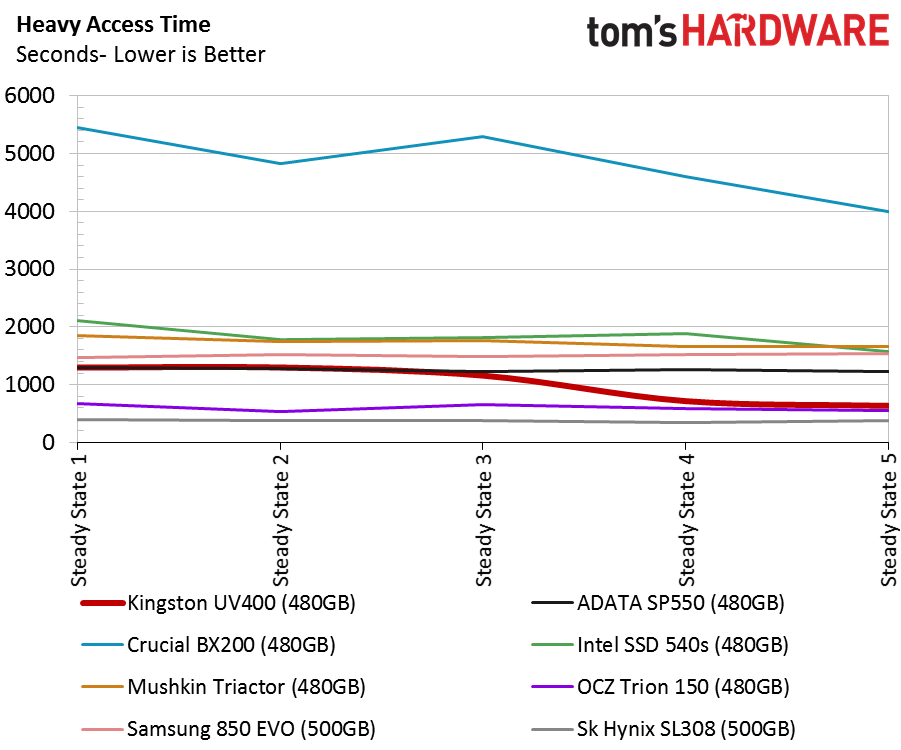
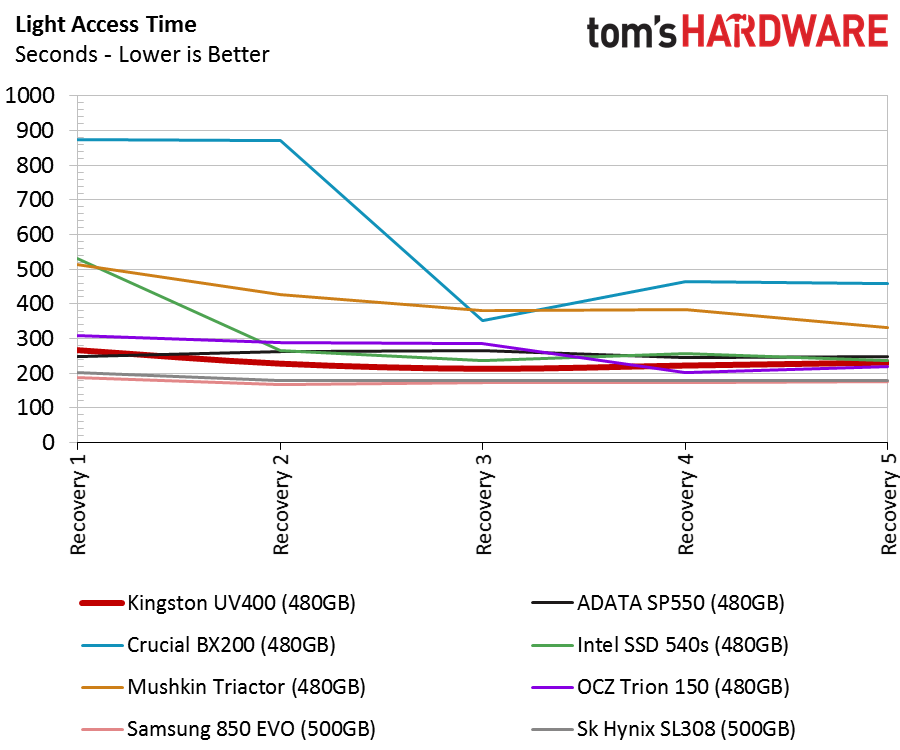
Surprisingly, the Kingston UV400 480GB turns in a positive result in the service time tests. Really good products like the SanDisk Extreme Pro perform the tasks twice as fast as the other products in the chart, so the performance is relative to the value-focused products and not a blanket statement covering all SATA SSDs.
Disk Busy Time
The UV400 takes longer to complete tasks than many of the other products before it returns to an idle state. The return to idle time equates directly to the amount of battery power consumed, and this tendency will show up in the notebook battery life test.
Notebook Battery Life
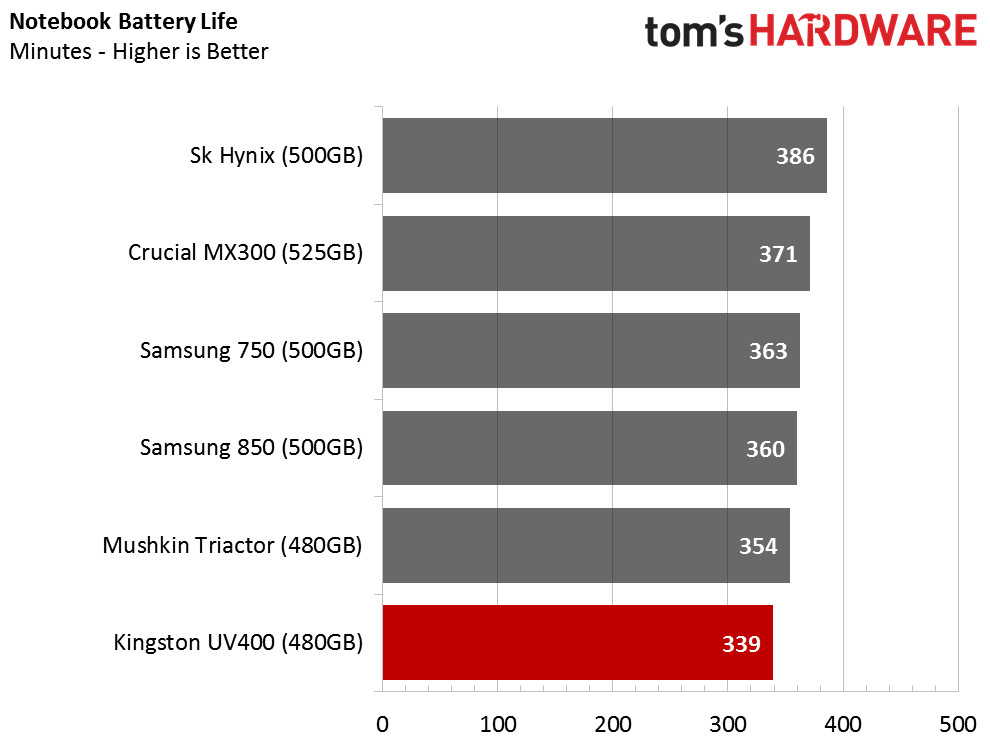
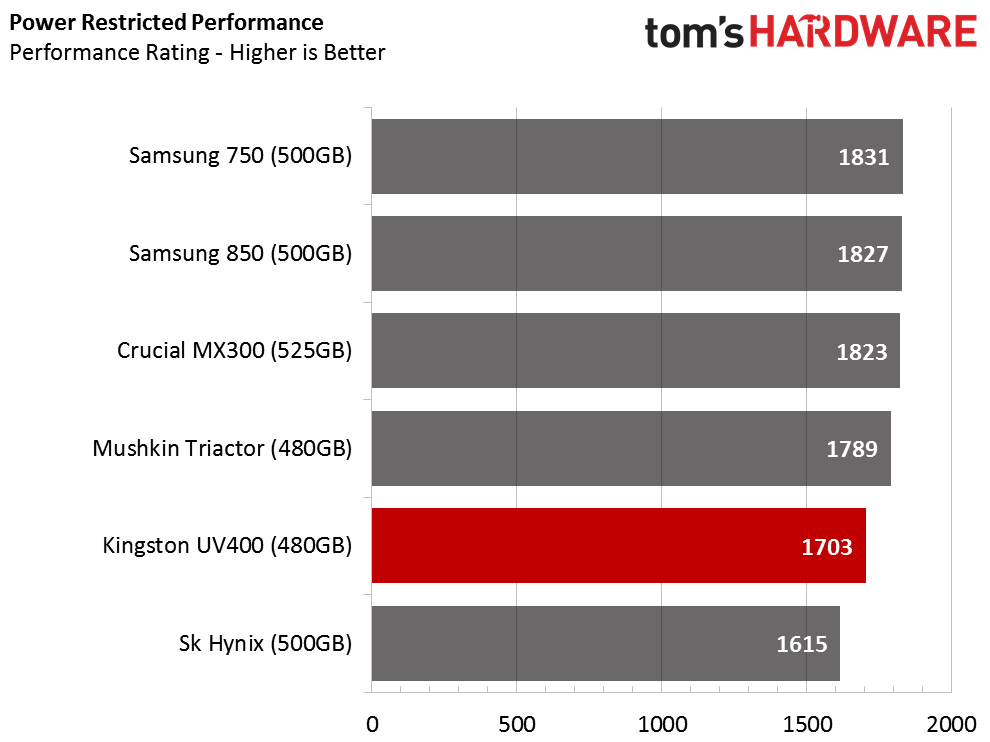
The Kingston UV400 480GB consumes a lot of battery power. We wouldn't recommend this drive for notebook users who frequently need long battery life for work or other activities. The UV400's performance in a power-restricted environment is also low. TLC flash consumes more power than MLC, so it takes a lot of optimizations to make TLC SSDs perform well in this test.
MORE: Best SSDs
MORE: Latest Storage News
MORE: Storage in the Forums

Chris Ramseyer was a senior contributing editor for Tom's Hardware. He tested and reviewed consumer storage.
-
daglesj I got one of these in to test a few weeks ago. The sustained Write speeds of 100MBps matched in with my findings too. Not great but 4 times better then the awful BX200 that dropped to USB2.0 speeds. It will do the job.Reply -
Lutfij I only hope that they didn't send cherry picked units for the purpose of this review. The issue as per their last outing was that Kingston reduced their QC on the Vnow units and were the sole reason why the customers were furious to ask for a refund or multiple RMA's.Reply
In spite of being a little better than lower end SSD's they should maintain that all customers and reviewers get a fair share of the performance. SK Hynix has been following that trend and it's helped them a lot in the market. -
3ogdy This is so close in price to the V300 where I live that I'm wondering what its point on the market is. Actually, the 120GB version is $1 more eXPensive than the 120GB V300. Go figure.Reply
Also, ease up on the marketing. "On a beggar's budget"? They don't provide anything special at all: Check Toshiba's Q300, Avexir's E100, Kingston's own V300, SanDisk's SSD Plus. All those are CHEAPER than the so-called UltraValue 400.
And it's funny how the UltraValue is exactly $1.75 cheaper than Kingston's HyperX and $8 cheaper than a 120GB 850 EVO. Margins must be razor sharp.
I for one am still waiting for the day these 120GB capacity SSDs are completelyvanished from the market and the 250GB SSDs become the new 120GB. Half a TB SSDs are still extremely overpriced - over $100 for that in 2016?! Those shouldn't be sold for more than $70, but I guess the only thing we can do is avoid the more expensive products till they come down in price or simply wait if we already happen to be on an SSD. -
Pixdawg @TADASHITG & CINERGY - the point here is that you can buy two of these or one 850 EVO with the same stash of money. I guess neither of you can grasp the concept of 'value'. Your problem, nobody else's.Reply -
3ogdy Reply18650259 said:So the drive is so value oriented that the review itself is half done...
You must be an AnandTech reader. It's known those guys have more in-depth reviews. Even with Anand gone, some reviews over there really shine in comparison with ...well...the rest of them. Their latest SSD review has three times as many pages as this one, but this one has more content on each page.
It's definitely taken some time for the reviewer to do this and I appreciate the work. It's not Tom's that's doing a bad job - they do upper-average (if that even exists) to great reviews andsometimes hit the nail on the head, coming up with outstandingly good material. Many other websites do straight up average reviews and it definitely shows. They review things with very little material, outright missing crucial hardware comparisons and it becomes extremely irritating when such omissions occur. "Why the duck would you compare the new E-Class to a 5 year old Renault and not to something like the latest 5-series and the previous generation?". This applies to everything from CPUs to GPUs, SSDs...etc. Had they omitted the 850 EVO in the graphs, I would've called this straight up marketing.
While in my particular case I disagree with the wording and the UltraValue moniker mainly thanks to the fact that there's no such thing as an even "positive" difference in terms of pricing vs V300, the review is OK.
